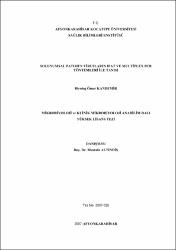| dc.description.abstract | Accurate detection of respiratory viruses is important to guide antiviral
therapy, prevent nosocomial spread, provide surveillance and in some cases, decrease
hospital costs and lengths of stay. By using standard laboratory methods, such as
staining with fluorescent antibodies (FAT) and isolation by culture, viruses have been
detected in 13 to 45 % of children with symptoms of respiratory illness. In this study;
two diagnostic methods used for respiratory viruses have shown acute respiratory
tract infection symptoms in childrens.
Detection of IgM antibodies from blood by fluorescent-antibody (FATEuroimmun
GmbH Germany) and Multiplex RT PCR assays (Hexaplex Plus,
Prodesse Inc. USA) for detection of respiratory syncytial virus (RSV), influenza virus
type A (FluA), influenza virus type B (FluB), parainfluenza virus types 1, 2, and 3
(PIV1, PIV2, and PIV3), human metapneumovirus (MPV) and adenovirus (AdV)
from nasopharyngeal samples. A multiplex quantitative reverse transcriptionpolymerase
chain reaction-enzyme hybridization assay (RT-PCR) was developed and
used to rapidly detect and quantitative RNA of seven viruses in nasopharyngeal
specimens in a single test. Primers and probes originated from highly conserved
regions of each viral genome. Six and a half primer pairs were mixed for the
simultaneous detection and quantitation of RNA from seven different respiratory
viruses. This was carried out in 46 nasopharyngeal and bloods specimens from
children with respiratory illnesses collected over a 1-year period.
The median age of the patients from whom the specimens were collected was
16.4 ± 4.5 months (range 2 months to 13 years); Fifty-two percent of samples were
from male patients, and 48 % were from female patients. Of these 46 blood
specimens, 13 (28.3 %) were positive by FAT (2 for RSV, 9 for FluA-H1N1, H3N2,
8 for FluB, 3 for PIV3). Of these 46 nasopharyngeal specimens, 8 (17.4 %) were
positive by Multiplex PCR (1 for RSV, 8 for FluA, 1 for FluB, 3 for PIV3, 5 for
MPV, and 1 for both FluA and 5 for hMPV, AdV absent in Hexaplex Plus). The
number of specimens positive only by PCR among specimens positive by PCR and/or
FAT was 1 (50.0 %) of 2 for RSV, 8 (88.9 %) of 9 for FluA, 3 (100 %) of 3 for PIV3
(P < 0.001).
Use of both Multiplex PCR and FAT to identify viral respiratory pathogens in
children will lead to improved diagnosis of respiratory illness. | en_US |



















